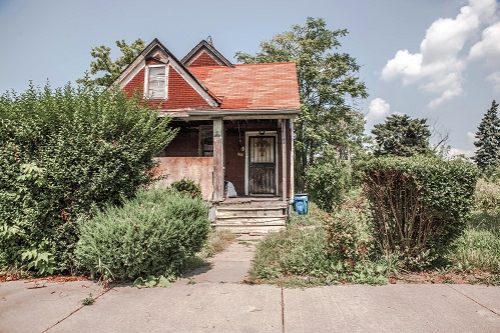- What are the most common winter weather damages?
- Does home insurance cover winter storm damage?
- Which home insurance coverages apply to winter-related damages?
- What isn’t covered by home insurance after a winter storm?
- Does condo insurance cover winter storms?
- Does renters insurance cover winter storms?
- Does car insurance cover winter damage?
- Preventative measures to reduce the risk of winter weather damage
- FAQ: Insurance for winter damage
What are the most common winter weather damages?
The most common types of damage from winter weather include:
Structural damage from snow and ice weight.
Heavy snow and ice accumulation can collapse roofs, damage gutters, and strain older structures. Homes in snow-prone regions face significant risk if weight thresholds are exceeded.
Water damage from freezing, ice dams, and burst pipes.
Pipes can freeze and burst during prolonged cold, especially in unheated areas. Ice dams form when warm air melts roof snow that then refreezes at the eaves, backing water into ceilings and walls.
Flooding from snowmelt or ice-dam leaks.
Rapid thaws or rain-on-snow events can overwhelm drains and cause basement or ground-floor flooding. Ice dams can also leak water inside walls, causing hidden rot or mold.
Heating system failures, fires & utility breakdowns.
Overused or poorly maintained heating systems may fail or start fires. Space heaters and blocked vents increase fire risk. Utility outages during cold snaps can lead to secondary damage.
Gradual wear from freeze–thaw cycles.
Repeated freezing and thawing can cause cracks in foundations, driveways, and siding. Water seepage and long-term wear may not be covered as "sudden" damage.
Liability from slips, falls, and third-party injuries.
Uncleared snow or ice on driveways and sidewalks can result in injuries and liability claims from visitors or delivery workers.
Does home insurance cover winter storm damage?
Your home insurance policy covers winter storm damage to your home, other structures on your property and often even trees and bushes. You can expect home insurance to cover:
- Damage to your roof from the weight of snow and ice
- Frozen pipes and water damage when they burst
- Damage to personal property if snow or ice gets into the home
- Damage from falling trees or branches
- Damage from strong winds
Which home insurance coverages apply to winter-related damages?
After a winter storm, any or all of these coverages will kick in to get you back on your feet.
Dwelling coverage. Covers the house itself and any attached structures up to the replacement cost listed on the policy. Dwelling coverage will pay to replace your roof if it collapses under the weight of snow or your deck if a winter storm causes a tree to fall on it.
Other structures. This coverage pays for damage to structures on your property that are not attached to the house, like a shed, fence or detached garage.
Personal property. This covers all of the personal property in your home, from your towels to your TV. If your roof collapses due to snow or ice and items inside your house are damaged, this coverage will pay to replace or repair them.
Loss of use/additional living expenses. If covered winter storm damage to your home is so extensive that you can’t live there during repairs, additional living expenses (ALE) coverage kicks in to pay for hotel and other extra living expenses.
Does home insurance cover someone slipping on the ice?
If someone slips and falls on ice on your property, your home insurance liability coverage and medical payments will pay for medical bills or resulting lawsuits.
Liability coverage only applies to other people. If you or a member of your household slips and is injured, home insurance doesn’t cover you. Your health insurance will kick in instead.
What isn’t covered by home insurance after a winter storm?
Homeowners insurance generally excludes damage caused by snow and ice to certain structures. They include:
- Docks and piers
- Patios
- Awnings and canopies
- Swimming pools
- Retaining walls
- Pavement
Be sure to read your policy carefully to find out what’s excluded.
Furthermore, standard homeowners insurance policies don't cover:
- Flood damage. If heavy melting snow causes a flood, that damage would only be covered if you have a flood insurance policy.
- Neglect and lack of maintenance. Damage caused by failure to maintain your home and property, including trimming trees and clearing snow, may not be covered.
- Gradual damage and mold. Insurance covers sudden, accidental damage, so damage that happens over time isn't covered. Furthermore, mold generally isn't covered.
Does condo insurance cover winter storms?
Condo insurance covers winter storm damage to your personal property and to any part of the condo itself for which you are responsible.
Your condo association’s policy will cover the structure itself, but depending on how it’s set up, you might be responsible for some internal parts of the structure. Like home insurance, condo insurance also provides additional living expenses coverage.
Does renters insurance cover winter storms?
Your landlord is responsible for insuring the house or apartment building you live in, but that doesn’t cover your personal property. A renters insurance policy will pay for any damage to your personal property caused by snow, ice or other winter weather. It also includes coverage for loss of use.
Does car insurance cover winter damage?
Winter weather can cause a wide variety of damage to your car, not the least of which is the increased risk of an accident when roads are icy or snowy, or when visibility is low.
Your car insurance policy provides several options for covering winter weather-related damage. If you’re in an accident and are found at fault, liability insurance will pay for any damage or injuries you cause.
For damage to your car in an accident, including a single-car accident such as your car sliding off of the road and into a ditch, you will need to carry collision coverage.
Finally, comprehensive coverage pays for any non-collision damage to your car, such as that caused by weather. If a chunk of ice slides off of the roof and breaks your windshield, comprehensive will cover it. And unlike home insurance, comprehensive car insurance does cover floods, so if that snowmelt gets in your car, you’re covered.
Does car insurance cover snow damage?
Your car insurance will cover damage done by snow as long as you carry comprehensive coverage. The weight of ice and snow can cause dents on the hood and roof, which is covered by insurance. However, rust caused by snow over time is not covered by insurance.
Preventative measures to reduce the risk of winter weather damage
As climate change drives winter storms into new places and changes both temperatures and snowfall totals, preparing for winter is even more important. Even if the damage is covered, no one wants to deal with repairing a roof or frozen pipes.
Take steps to avoid a winter claim, including:
- Pre-winter maintenance. Inspect and maintain your roof, heating system, gutters, insulation, and exterior caulking. Document all work.
- Safe heating practices. Keep flammable materials away from space heaters, test smoke and CO detectors, and maintain proper ventilation.
- Snow and ice removal. Regularly clear snow from roofs, eaves, walkways, and around foundations. Use de-icers as needed.
FAQ: Insurance for winter damage
Does my insurance cover frozen pipes if I'm on vacation?
Yes, but there may be clauses in the policy that require you to have taken precautions while you're away, including keeping the heat at a level that will prevent freezing.
Do I need flood insurance for snowmelt flooding?
Yes. Snowmelt flooding is not covered by standard homeowners insurance, which excludes damage from overland flooding.




